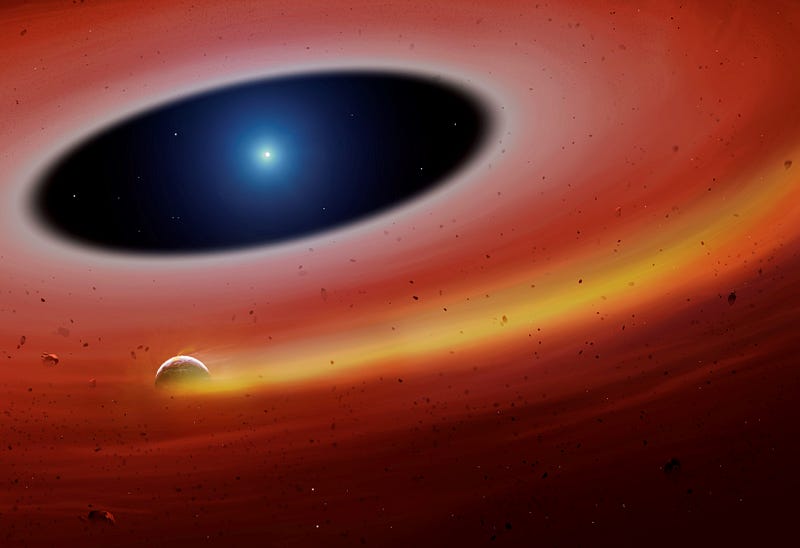Discovering a Dense Planet Orbiting a White Dwarf Star
Written on
Chapter 1: An Unprecedented Discovery
Recent observations have revealed a small, dense planet in orbit around a white dwarf star, marking a groundbreaking milestone for astronomers. This finding provides valuable insights into the later stages of star systems, including our own.
This paragraph will result in an indented block of text, typically used for quoting other text.
Section 1.1: The Discovery Process
The small planetary fragment is orbiting the star designated SDSS J122859.93+104032.9, leaving a distinctive trail of gas in its path (University of Warwick/Mark Garlick).

When stars comparable in size to our Sun deplete their nuclear fuel, they transform into white dwarfs—a hot, compact stellar core encased in a nebula formed from the star's outer layers. Scientists have speculated for years that these white dwarfs might host surviving planets within their debris fields, remnants of planets that were destroyed as the outer layers were expelled.
Despite this theory, evidence of intact planets surrounding white dwarfs had remained elusive until now. Christopher Manser, the lead researcher on this remarkable discovery, expressed surprise at the outcome, stating: “When we initially gathered our data, we did not anticipate discovering a planetesimal, making this an incredible result!”
Manser, affiliated with the Department of Physics at the University of Warwick, and his team applied spectroscopy to analyze the gas within the debris disc encircling the white dwarf SDSS J122859.93+104032.9. This examination uncovered periodic fluctuations in gas emissions, which they concluded were indicative of a planetesimal orbiting within the disc. This represents the first identification of an intact planetesimal in orbit around a white dwarf.
He elaborated: “Initially, we were searching for random collisions between dust particles in the disc, which would create gas that we could observe as minor flares in the emission from the disc. What we detected instead was a consistent, periodic signal, which we are now confident reveals the presence of a planetesimal.”
The research team estimated that the planetesimal, which completes an orbit every two hours, must possess a remarkable density and measure no more than 600 kilometers in diameter to withstand the gravitational pull of the star without disintegrating.
Manser stated: “This is a significant finding since we previously believed that any matter venturing this close to the white dwarf would be torn apart, forming a disc similar to the one this planetesimal is orbiting.”
The object's elevated density provided clues regarding its origins; researchers suspect it is a remnant core of a planet, with its outer layers having been violently stripped away due to the tidal forces exerted by the star.
Manser further explained: “This ultimately enhances our understanding of how celestial bodies are directed toward the white dwarf, undergo partial or complete disruption, and eventually get consumed by the star.”
Luca Fossati, a group leader at the Austrian Academy of Sciences, noted that the methodologies employed in this study could assist in identifying other planetesimals orbiting white dwarfs that traditional planet-hunting techniques might miss.
Looking ahead, Manser commented on their future research endeavors: “We plan to gather additional observations of SDSS J122859.93+104032.9 to uncover any intriguing characteristics of the planetesimal. We also intend to explore other gas discs around white dwarfs, utilizing our developed methods to discover more planetesimals in close orbits around their respective stars.”
The research, funded by the European Research Council (ERC), is featured in the latest issue of the journal Science.
Original research: http://dx.doi.org/10.1126/science.aat5330
Also published at Scisco Media
Chapter 2: Exploring the Implications
The first video, "The Smallest Exoplanet Orbits A White Dwarf Star," delves into the complexities of this discovery, examining the implications for our understanding of exoplanets and their environments.
The second video, "Can a White Dwarf Have Habitable Planets?" explores the potential for habitability around white dwarf stars and what this finding means for the search for life beyond our solar system.